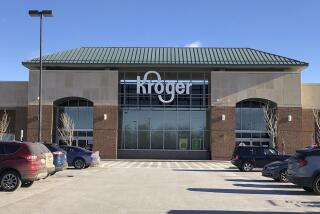Reporting on Retail Business Signage Was Short on Facts
- Share via
* If one questions the bias of the press, one only needs to read an article on a topic of which one has specific knowledge. Your front-page assault on the basic retail business sector’s use of signage (“Signs Offer a Space for Debate,” April 16) is a reckless piece of one-sided reporting. Please allow a few facts that may help your readers better understand this heated debate that rages at local government statewide.
Government has played a rather degenerative role in curing the “visual blight” you described. The city of Los Angeles has adopted new restrictions that perpetuate this condition. These more restrictive ordinances prohibit business owners from changing their signs without the virtual loss of all identification.
Allow me an accurate yet hypothetical scenario. A fast-food company desires to convert a vacant restaurant building along this specific section of Ventura Boulevard. The old business had a large sign, the shape of an ice cream cone, 35 feet high. The new fast-food folks desire a new sign with a much more appealing and contemporary graphic only 15 feet high. The new, excessively restrictive ordinance gives the restaurant owner just two options: keep the ice cream cone sign, changing only the name, or install a new sign based on the current regulatory standard, which is too small to have any impact. The owner has only one real option; a bad sign is better than no sign. Therefore, the old ice cream cone stays as a hideous adaptation attempting to identify the new business.
Your article described an ongoing debate within the city of Agoura Hills. You quote a city official declaring that its efforts to further regulate business signs would translate into only a $57,000 loss in sales tax revenue to the city. But what loss in sales to the business community accounts for a $57,000 loss in sales tax? The city’s same report determined McDonald’s alone would lose one-third of its total sales with the removal of its sign. This calculates into a revenue drop of more than $1 million per year, not to mention the obvious loss of jobs. Similar outcomes were forecast for at least a dozen business owners in Agoura Hills.
Factual misrepresentations aside, you missed the most significant point of the analysis. What purpose does a sign serve and why are they utilized in the first place? Signs have two basic functions: identification and advertising. The identification role is obvious. Advertising is a concept not foreign to the newspaper trade. The retailer is attempting to link, in the mind of the consumer, the graphic identity of the firm (the sign) with the content and appeal of its advertising. This basic market reality is fundamental to retail and general business success.
JOHN M. BAKER
Fullerton
Baker is an executive committee member of the Sign User’s Council of California and was sign program manager of Carl’s Jr. Restaurants from 1989 to 1994 .
More to Read
Inside the business of entertainment
The Wide Shot brings you news, analysis and insights on everything from streaming wars to production — and what it all means for the future.
You may occasionally receive promotional content from the Los Angeles Times.










